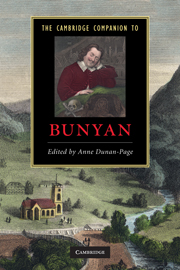Book contents
- Frontmatter
- Introduction
- Part I John Bunyan in his seventeenth-century context
- 1 John Bunyan’s literary life
- 2 John Bunyan and Restoration literature
- 3 John Bunyan and the Bible
- 4 John Bunyan and the goodwives of Bedford: a psychoanalytic approach
- Part II John Bunyan’s major works
- Part III Readership and reception
- Guide to further reading
- Index
3 - John Bunyan and the Bible
from Part I - John Bunyan in his seventeenth-century context
Published online by Cambridge University Press: 28 July 2010
- Frontmatter
- Introduction
- Part I John Bunyan in his seventeenth-century context
- 1 John Bunyan’s literary life
- 2 John Bunyan and Restoration literature
- 3 John Bunyan and the Bible
- 4 John Bunyan and the goodwives of Bedford: a psychoanalytic approach
- Part II John Bunyan’s major works
- Part III Readership and reception
- Guide to further reading
- Index
Summary
In the opening scene of The Pilgrim's Progress we are presented with the spectacle of a burdened man, wearing ragged clothing, and reading a book: 'I dreamed, and behold I saw a Man cloathed with Raggs, standing in a certain place, with his face from his own House, a Book in his hand, and a great burden upon his Back. I looked, and saw him open the Book, and Read therein; and as he read, he wept and trembled' (P'sP, p. 8). His family and friends cannot understand what is troubling the poor man, and he for his part withdraws from them, still anxiously reading his book. Then one day,we are told, 'when he was walking in the Fields . . . reading in his Book, and greatly distressed in his mind . . . he burst out . . . crying, What shall I do to be saved?' (P'sP, p. 9). The book that prompts this outburst is the Bible, to which a series of references is given in the margin, and indeed the very words are those of the trembling jailer to the Apostle Paul as recounted in Acts 16:30. This memorable scene establishes at the outset that Bible-reading will be a central theme in Bunyan's allegory, and, as we shall see, the pilgrim's developing ability to read and understand the Bible parallels in many ways the account Bunyan gives of his own experience in his spiritual autobiography, Grace Abounding to the Chief of Sinners (1666). For Bunyan, the Bible was the only book that really mattered. 'Thou must give more credit to one syllable of the written Word of the Gospel', he says on one occasion, 'than thou must give to all the Saints and Angels in Heaven and Earth' (MW, II:191).
- Type
- Chapter
- Information
- The Cambridge Companion to Bunyan , pp. 39 - 50Publisher: Cambridge University PressPrint publication year: 2010
- 1
- Cited by



